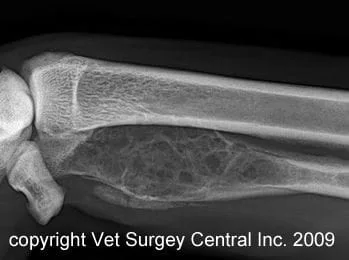Key Points
Bone cysts are more common in young dogs
These cysts can cause lameness and pain
Surgery is the best option
Prognosis generally is good with treatment
Anatomy
- Almost everyone has snapped a chicken bone in two and discovered that the bone has a hard outer shell called the cortex and an inner soft part that contains fat and is called the bone marrow.
What is a bone cyst?
- A bone cyst is an expansile structure within the bone marrow cavity that gradually grows and weakens the bone to the point of causing the bone to fracture
- A bone cyst can be caused by an arteriovenous fistulae. This is a direct connection of an artery into a vein within the marrow cavity. With time this causes the marrow cavity to expand and thin out the outer part of the bone.
Types of bone cysts
- Simple or unicameral cyst can be caused by trauma, blood clot formation, increased numbers of bone melting cells (osteoclasts), obstruction of blood within veins in the bone (venous obstruction) and fluid accumulation within the bone.
- Aneurysmal bone cysts can be secondary to a traumatic event to the blood vessels within the bone which leads to the formation of an abnormal connection between an artery and vein (called an arteriovenous fistula). The increased blood supply within the marrow cavity erodes the bone, thus the cyst forms. One dog has been reported to have an aneurysmal bone cyst associated with a chondrosarcoma bone cancer.
Signs of a bone cyst
- Signalment: any breed can be affected, dogs are usually less than 18 months of age (although aneurysmal bone cysts are also found in older dogs), both males and females can be affected
- Signs: lameness is the most common sign. A swelling of the bone may be noted and this may be painful when direct pressure is applied to the cyst. In some cases the bone may break (fracture), although this is not common.
How common is this disease?
- Uncommon
Diagnosis
- A biopsy is required to make a diagnosis as this lesion can look very similar to bone cancer (see comparison of bone cancer and cyst).
Bone cyst
Age: less than 18 months of age
Slow growing
Typically has a trabeculated bone pattern
Usually dose not have abundant reaction on outer bone
Usually located near the end of the bone, but can be anywhere

Figure above: Aneurysmal bone cyst in a 1 yr old Labrador that was lame on the forelimb.
Bone cancer
Age: mid to older dogs affected
Usually rapidly growing
Typically has bone destruction with trabeculated pattern
Frequently has abundant reaction on outside of bone(peristalses reaction)
Usually located near the end of the bone

Figure above: Osteosarcoma (bone cancer) in an 8 yr old Shar Pei that was lame; take note that this tumor does not look much different than the bone cyst seen right other than it is less trabeculated.

Treatment
- Removal of affected bone is usually curative. Radiograph right is of the case as seen above (aneurysmal bone cyst); histological margins were clean in this dog. Dogs can function very well without the lower half of the ulna bone; this dog recovered very well and had no lameness. Take note of the bone screw which was used to reattach the tip of the ulna bone which is attached to the lateral collateral ligament of the carpus (wrist).
- The inside of the bone cyst can be scraped and filled with bone graft; increased failure rate is seen with aneurysmal bone cysts; aneurysmal bone cysts may transform into a malignant tumor with curettage and grafting.
- There has been one report of filling the bone cyst with methyl methacrylate (bone cement).
Prognosis
- Favorable prognosis with curettage and bone grafting of simple bone cysts
- Aneurysmal bone cysts respond better to resection of the affected bone
References
- MacInnes T J, Thompson M S & Lewis D D. What’s your diagnosis? JAVMA 227, 1561-1562 (2005)
- Sarierler M, Cullu E, Yurekli Y et al Bone cement treatment for aneurysmal bone cyst in a dog. J Vet Med Sci 66,1137-1142 (2004)
- Beckman B W Radicular cyst of the premaxilla in a dog. J Vet Dent 20, 213-217 (2003)
- Barnhart M D Malignant transformation of an aneurysmal bone cyst in a dog. Vet Surg 31, 519-524 (2002)
- Stickle R, Flo G, Render J Radiographic diagnosis – benign bone cyst. Vet Rad and Ultrasound 40, 365-366 (1999)
- Nomura K, Sato K Pelvic aneurysmal bone cyst in a dog. J Vet Med Sci 59, 1027-1030 (1997)
- Duval J M, Chambers J N & Newell S M Surgical treatment of an aneurysmal bone cyst in a dog. Vet Comp Ortho Traumatol 8, 213-217 (1995)
- Schrader S C, Burk R L, Lin S Bone cysts in two dogs and a review of similar cystic bone lesions in the dog. JAVMA 182, 490-495 (1983)
- Kelly C et al The Use of a Surgical Grade Calcium Sulfate as a Bone Graft Substitute: Results of a Multicenter Trial. SECTION I SYMPOSIUM Clinical Orthopaedics & Related Research 382, 42-50, January 2001
- Resnick D, Kyriakos M, Guerdon D et al. Tumors and tumor like lesions of bone: imaging and pathology of specific lesions. In: Resnick D, ed. Diagnosis of bone and joint disorders. 3rd ed. Philadelphia: WB Saunders Co. pp 3559–3576 (1995)
- Halliwell W H Tumour like lesions of bone. In: Disease mechanisms in Small Animal Surgery Bojrab MJ. Ed Philadelphia: Lea and Febiger. pp 932-943 (1993)


